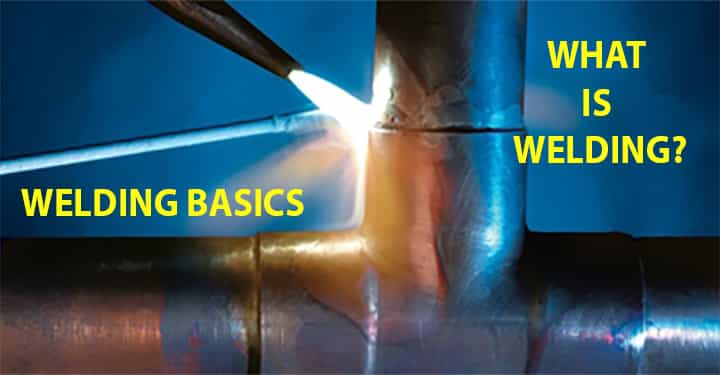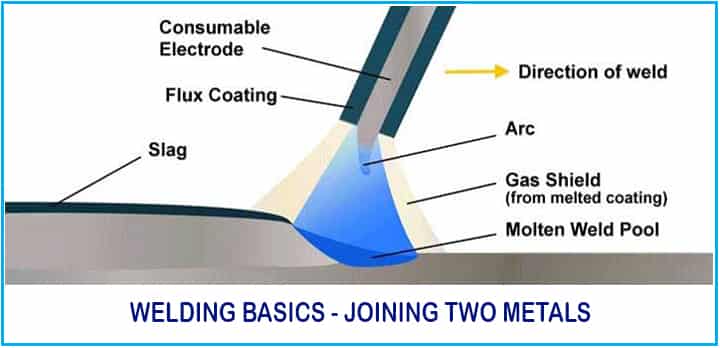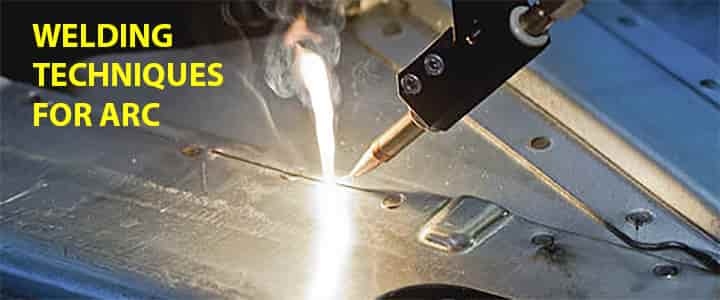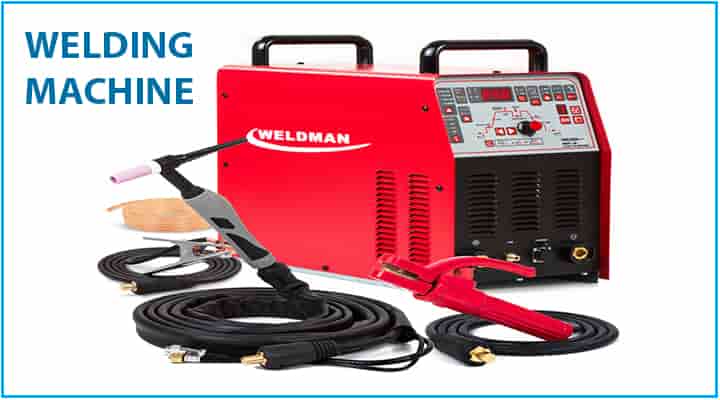What is welding? – a very common question in manufacturing industries. In this article, we will the basics of welding, its definition, detailed understanding, welding process, welding equipment, and tools, etc., and clear all the doubts about welding. Let’s welcome what is welding!
What is Welding? Basics
Welding Basics
Before discussion to the welding, we will learn welding basics. Since the Stone Age, we humans are in the process of discovering various stones and metals to make tools for daily use.
- When we talk about recent times, still we are continuous search of making and breaking stuff.
- To make every innovation successful, we break things and then join it again to build new tools and structures and the concept of welding comes.

Welding meaning, one of the fabricating processes to develop parts and an integral portion of making structures.
Purpose of Welding
The main purpose of welding is,
- To join two or more elements.
- To make a strong or firm connection between elements.
- To join metals.
- To join non-metals.
- To create all modern appliances, cars, planes, ships, etc., and what not!
- There are many modern welding techniques, which create a large range of welding.
History of Welding
You may think that the existence of welding is from a long time back, yes, you are right. Since the Iron Age and Bronze Age, welding in some other form has existed. There is evidence of its presence from more than 2,000 years ago.
- In the 18th century, traditional welding came through, and in the same year, our first electric arc was produced by Sir Humphry Davy.
- The first electric arc was made between two carbon electrodes by using a battery.
- Eventually, welding was started by Augusta De Meritens, he joined lead plates by using Arc heat. One of his students named Nikolai Benardos of Russian nationality had patented a process of electric arc welding using carbon rods.
- After this, the process of welding advanced swiftly. Consecutively, Nikolai Slavynov performed welding using an electric rod, and after this, an American engineer, namely C.L Coffin determined another welding process by utilizing metal coated electrodes.
Welding Definition & Meaning
Definition of Welding
Welding is basically a joining process of metals, or plastics. The joining portion of metals is fused by applying heat or pressure and mixed with properties similar to those of the materials being joined to produce a new joint.

This process is called welding.
- Welding is normally applied to metals and plastics.
- It can also apply even on wood as well.
- There should be one heat source. An electric arc is most common, apart from it, there are many others as well.
- Electrode and the base metal.
- Gas Shielding, to protect the weld from the air.
- The filler material used to join the two pieces together.
Let us dive straight into the world of machinery welding.
Welding Meaning
After welding definition, let’s try to understand the meaning of welding. You may have heard this terminology before or even saw the process before your eyes. Whatever you saw or know about welding is going to be enhanced by some more facts. We are going to add some more specific points to it.
- Welding is an essential component of metal fabrication, precisely a method or process of joining two different metals or thermoplastic by the application of heat as well as pressure.
- Welding means uniting metal parts together by surface heating or any other means. Weld is an English term that was coined in the late 16th century in the context of becoming united.
- The process of consolidation or uniting utilizing hammering or compression is known as welding.
- By applying a typical amount of heat and pressure to unite two or more parts permanently, one can achieve welding. Often metals are used during the process of welding.
Development of Welding in Recent Times
With the advent of efficient techniques in the 19th century, people tried to discover more methodologies for faster and effective welding processes.
- With so much advancement in welding techniques nowadays, robotic welding is being preferred.
- As the name suggests, it is a popular method that utilizes computer control for welding metals swiftly and effectively than ever before.
- When compared with conventional manual welding methods, robotic welding emerged as accurate as well as a fast process for welding.
- With the usage of robotic welding, there is less risk of life in it. Now we can think of many new advancements in the 21st century in the welding processes.
- Some of the automated welding techniques are known to perform efficiently and produce high-quality tools using various fabrication services.
Welding Techniques or Process
With the advancement of technology in every field, welding has also gone through several different improvements to perform the process. In this section of this excerpt, we are going to emphasize various techniques utilized in the welding process. Here, goes the list:
- Laser
- Arc
- Friction
- Electron beam
- Resistance
- Induction
- Oxyfuel
- Solid reactant
Laser: The laser is one of the advanced techniques that ease the process of welding.

- It is commonly used to unite pieces of metal or thermoplastics.
- The laser is a means to provide a concentrated amount of heat suitable for deep welds and barrows.
- Furthermore, this method is much more automated than the conventional ones,
- It offers higher welding speed and perfection in the welding applications.
One more benefit of this type of technique is that it allows the process to take place in the air rather than vacuum.
Arc: One of the most common techniques to perform welding is the utilization of arc.
- This type of arc welding includes numerous typical manual, automatic and semi-automatic welding processes.
- MIG welding, TIG welding, gas welding and many more types of welding are performed using arc.
- This is quite popular because of its most challenging characteristic of melting the hardest metals.
- It entirely relies on an electric arc to complete the joining of two or more materials.
- It is entirely suitable for offshore projects of welding as it can be performed underwater.
Friction: This method of welding involves the usage of mechanical friction to join materials.
- There are more than several ways to apply friction for welding on any material.
- To be more precise as the mechanical friction is known to generate immense heat to soften the material which is needed to be mixed for the joint.
- Furthermore, this type of welding doesn’t need filler materials, shielding gas or flux.
Electron beam: In this way of performing welding high-velocity, electron beams are used to join metals.
- The melting of materials is caused by the kinetic energy of the electrons that is transformed into heat.
- This type of welding is performed in a vacuum chamber to prevent the dissipation of electron beams.
Resistance: It is one of the fast welding processes that are quite popular in the automobile industry.
- This resistance welding can be diversified into two types as spot and seam welding.
- To be more concise spot welding utilizes the delivered heat between two different electrodes on a small area of workpieces.
- Seam welding is quite similar to spot welding as it replaces the two electrodes with continuously rotating wheels.
Induction: This technique comes under the category of fusion welding as it involves no contact between the heat source and the surface of the object.
- Usually, a magnetic field is generated with a wrapped coil that holds the potential of heating the metal.
- The potential of the magnetic field is so powerful that it can quickly heat the metal and melt it for fusion.
Oxyfuel: This technique is one of the recent one, which contains oxygen to generate the flame for heating and joining the surfaces of materials.
- It also relies on the fusion class of welding.
- Here, oxygen is used to fuel the fire and create a scorching flame up to 4500 degrees Fahrenheit for melting the substances.
- Usually, oxygen is combined with a flammable gas to create the hot flame for the welding.
Solid reactant: This technique is categorized explicitly under chemical welding material with the help of chemical reactions. When various chemicals are mixed to make compounds for heat generation, this hot flame of heat is used to join two or more materials.
What are the Major Processes in Welding?
You must have been curious to know the in-depth processes involved in welding. Here we are with some more details.
- Welding is commonly achieved by melting the different parts, using a filler material to make the weld pool. This weld pool is then cooled, which results in a robust joint, also known as a weld.
- It would be best if you did not get confused between brazing, soldering, and welding. Though all three seem similar processes, there are some significant differences in between.
- Specifically, brazing and soldering don’t involve melting of the initial materials, and welding is all about melting a material between two or more components to fabricate a bond between all.
We have said that welding involves the application of heat and pressure, but one must have been thinking how and in what form. To answer this, we need to inform you that various energy forms can be utilized for welding.
Apart from using the gas flame that most of us know about, electric arc, electron beam, laser, ultrasound and friction is also widely used to perform welding. Today, we are going to unleash the knowledge box to know about welding, its basic types, and techniques.
Different Kinds of Welding
There are many different welding types, namely,
- OXY-Hydrogen Gas welding
- MIG Welding – Gas Metal Arc Welding (GMAW)
- Atomic Hydrogen Gas welding
- TIG Welding – Gas Tungsten Arc Welding (GTAW)
- Submerged arc welding (SAW welding)
- Stick Welding – Shielded Metal Arc Welding (SMAW)
- Air- Acetylene Gas welding
- Flux Welding – Cored Arc Welding (FCAW)
- Energy Beam Welding (EBW)
- Atomic Hydrogen Welding (AHW)

- Resistance welding
- OXY- Acetylene Gas Welding
- Gas Tungsten-Arc Welding
- Plasma Arc Welding
- Soldering
- Brazing
All these types of welding need to be discussed later on in detail.
Different Types of Welding Machines
There are a few different welding machines in industries. These welding machines are different types, sizes, based on the applications. Most common welding machines are, as follows,

- MIG welding machines.
- TIG welding machines.
- Thyristor Control MIG welding machines.
- Spot welding machines.
- Shielded metal arc welding machines.
Welding Equipment, Tools, and Accessories
Welding Tools or Equipment
The welding process is critical and it is related to heating, electricity, electric arc, etc. which are dangerous for welders. There are so many vital welding tools in the process, few of them are listed down to have a basic idea.
- Welder, to heat up the metal
- Electrodes
- Preheating equipment, as applicable
- Work table
- Chipping hammers
- Cleaning wire brushes
- Jigs and fixtures
- Welding gasses for Shielding
- Filler materials
- Gas nozzles
- Rods for example tungsten rod for TIG type welding
- Angle grinders for removing impurities like paint, slag, etc. from the metals.
- Abrasive discs are required in angle grinders
- Welding supports to hold the metals cautiously
- Welding clamps to clamp the metals properly
- A sheet metal gauge to measure the thickness of metals
- Purging cups
- Load cells to control resistance welding equipment
We will learn the details of all the above welding tools later on.
Welding Safety Equipment & Accessories
The following welding equipment or welding safety tools are necessary for undergoing the process,
- Welding gloves for protection of hands as well as fingers
- Welding helmets to protect the head
- Dust masks to protect our respiratory system from unwanted particles
- Welding glasses to protect the eyes
- Welding aprons or jackets
- Fire extinguisher
- First aid kits
Conclusion
These were some of the critical definitions, meanings, techniques used widely in welding. Typically the welding processes are used across various industries such as oil, gas, paper, automotive, power, nuclear power, mechanical structures, aerospace, and many more.
Welding is explored as a method of joining various kinds of material together without any use of adhesives. The utilization of welding is too much in our daily life. Therefore, understanding the basic concept behind welding is essential, and it is undoubtedly going to help you in the future. Any doubts! Please feel free to write to us!


Spot on with this write-up, I really assume this website needs far more consideration. I’ll probably be again to learn much more, thanks for that info.
I like that you pointed out how welding is an important part of metal fabrication. Welding is quite interesting, so I am now trying to learn more about this topic. From what I’ve learned so far, it seems various tools are being used for welding nowadays, like weld booths.
https://www.iap-airproducts.com/welding-booths